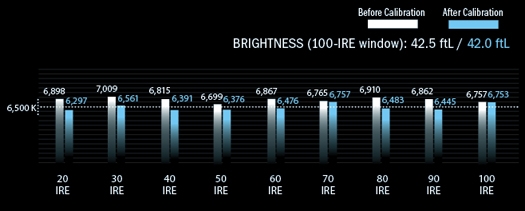Sony Bravia KDL-55XBR8 55-inch LCD HDTV Page 3
TEST BENCH

Primary Color Point Accuracy vs. SMPTE HD Standard
| Color | Target X | Measured X | Target Y | Measured Y |
| Red | 0.64 | 0.64 | 0.33 | 0.33 |
| Green | 0.30 | 0.30 | 0.60 | 0.61 |
| Blue | 0.15 | 0.15 | 0.06 | 0.06 |
Of the Sony's various picture presets, Custom delivered the most accurate color when the set's Warm color temperature mode was also selected. With those settings active, its grayscale tracking ended up being +/- 509 degrees K of the 6,500 K standard from 30 to 100 IRE - below-average performance. Making adjustments to the red, green, and blue gain and bias controls in the set's White balance menu improved grayscale tracking to +/-257 degrees K from 30 to 90 IRE. Color decoder tests revealed a -12.5 percent red -5 percent green pull for HDMI. The results here were slightly better on the component-video inputs. With the TV's Standard Color Space mode selected, its red, green, and blue color points all showed mild oversaturation as compared to the SMPTE HD specification.
Overscan - the amount of picture area hidden behind the edges of the TV's screen - measured 0% for 1080i and 720p-format high-definition signals with the Full Pixel mode active. The set fully resolved 1080i and 720p test patterns via its HDMI and component-video inputs, although a 480i-format pattern looked notably soft over an HDMI connection. Screen uniformity was excellent, with no sign of tinting, screen clouding, or uneven brightness on gray, black, and white full-field patterns. Viewing angle was poor as compared to other LCD TVs, with picture contrast dropping noticeably at seats 15-degrees off from the screen's center axis. Gamma measured in at 2.0, a level that was slightly off from the 2.2 target.
The Sony's video upconversion was for the most part good. In several instances, the set's Digital Reality Creation image enhancement processing affected performance. For example, the set failed the film resolution test on the Silicon Optix HQV high-def Blu-ray test disc with DRC turned off, but passed with DRC set to Mode 1. When the same setting was enabled, the Sony also managed to pass the Jaggies 2 and Flag standard-definition video upconversion tests on the DVD version of the HQV disc. DRC processing also made standard-def images look mildly crisper without adding edge enhancement, so I'd minimally keep switched on when watching standard-def programs on DVD or regular TV. The Sony's regular noise reduction mode worked well and didn't introduce any detail loss at any setting, but its MPEG noise reduction modes created noticeable blurring when they were switched on.













































